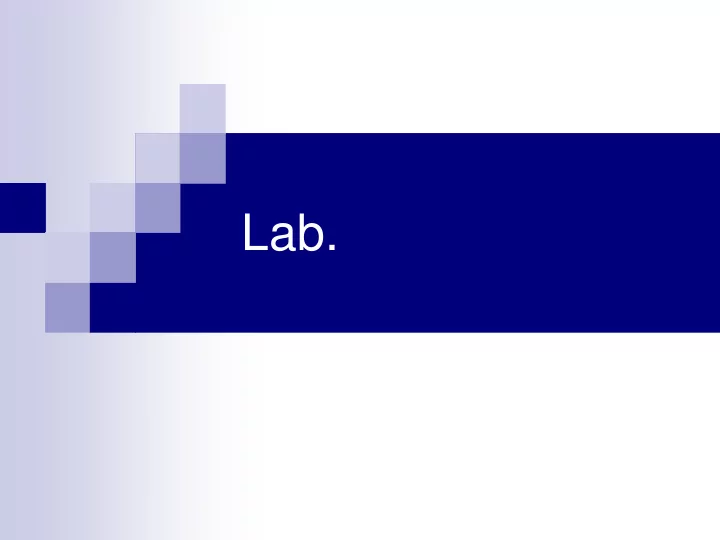

Lab.
Objectives and tools To implement Hello world Out Inout a FIR filter an IIR filter on the C6748 LCDK Tools: C6748 LCDK CCStudio 5.3.0 on a PC with Windows function generator oscilloscope projects (already prepared by the teacher)
Function (or signal) generator Normally, floating Main controls wave shape (sine, square, triangular...) amplitude frequency
Oscilloscope Normally grounded “Crocodile” tip is common, grounded; probe tip is the input Main controls: horizontal scale (time/div.) vertical scale (V/div.) coupling (AC/DC) trigger source several trigger options (put mode to “auto”)
Some notes • Pay attention to possible electrostatic discharges , especially in dry days • grep the PCB (printed circuit board) along its borders • don’t touch the electronic components • don’t touch the copper lines of the PCB • The left channel in the jack connectors should be the red wire, but please check 5
S/W installation • Method 1: • Copy the TI DVD on the hard disk • Install CCS from the hard disk • using ccslicense for the activation • copy the ccslicense.lic file in c:\Program Files\ti • in c:\Program Files\ti (or c:\Programmi\ti) • C6000, C6748, XDS100 • Method 2: • Download version 5.3 from http://software-dl.ti.com/ccs/esd/documents/ccs_downloads.html • follow instructions for the activation • in c:\Program Files\ti (or c:\Programmi\ti) • C6000, C6748, XDS100 • Then • Copy the assets folder in c:\Program Files\ti • Copy the projects_basic folder on the desktop 6
Starting CCS • Connect the LCDK to the PC using the XDS100v2 • dip switch: all off, i.e. towards the jack connector • For inout and fir_filter : line in at the top, line out at the bottom • Open CCS • File… new… target configuration file… file name : nameNewTargetConfiguration.ccxml, • set use shared location (or not?) • emulator: xds100v2 • LCDK6748 • Save 7
Loading, compiling and running projects • View/project_explorer • project… import existing CCS eclipse project… • it may be necessary to correct • the user name in the .project file of each project • the path for the include in “assets” • show build settings... C6000 compiler... include options • the path for the lib in “assets” • show build settings... C6000 linker... file search path • in file/properties , or in project properties • build.. c6000 compiler • optimization • advanced options / assembler options: keep asm files • the asm can be found in the Debug folder • (in edit mode) build • debug (moves to debug mode)
Our interrupts The 6748 has 128 interrupt sources, but room for only 16 ISRs (interrupt service routines) • 12 interrupts can be programmed [tms320c6748.pdf, p. 92] • interrupts 0 to 3 are RESET, NMI and 2 reserved For our interrupt: • MCASP0 (multichannel audio serial port 0) generates the event EVT 61 [tms320c6748.pdf, p. 93] • 61 (i.e. 0x3d) is written in the low part of the register INTMUX1 [L138_LCDK_aic3106_init.c, line 655] • the low part of the register INTMUX1 is associated with the interrupt INT4 [L138_LCDK_aic3106_init.c, line 653, and sprufk5a.pdf, p. 178] • the routine associated with INT4 (its code is in main.c) is interrupt 4 [vector_intr.asm, line 48]
Designing simple filters with Matlab • For e.g. a FIR passband filter • b=fir1(15, [0.2 0.3]); • freqz(b); • zplane(b); • For e.g. an IIR passband filter • [b,a]=butter(15, [0.2 0.3]); • freqz(b,a); • zplane(b,a); 10
Recommend
More recommend